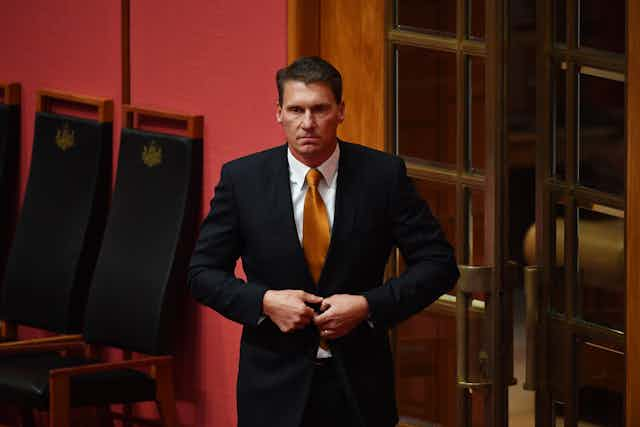Whether it be due to hubris, courage or vanity, South Australian senator Cory Bernardi has decided to forsake the Liberal Party under whose auspices his political career had been nourished.
He will instead seek to create his own political party, Australian Conservatives. According to the conventions of Australian political science, Bernardi’s new party will be categorised as a “minor” party. This means it will be expected to win a minute share of the vote at the next election, that its only prospect for representational success will be in the Senate, and that it will be expected to last no longer than one turn of the Senate electoral cycle.
The current excitement surrounding Bernardi’s defection from the Liberal Party arises because of the deleterious impact it has on Malcolm Turnbull’s leadership. It also adds to the complex situation in the Senate that is already under the influence of a diverse and often erratic crossbench.
This is a situation that could last for some time. Bernardi, who was the second-placed candidate on the South Australian Liberal ticket in the 2016 double-dissolution election, is what the Constitution defines as a “first-class” senator, and thus entitled to a six-year term.
Even though he was elected as a Liberal candidate, Bernardi is under no constitutional obligation to relinquish his seat, so he will now doubtlessly start work on forming his new party. Somewhat ironically, he will be doing that under elections laws recently changed by the Turnbull government designed to make it harder for new parties to be formed, and restricting their ability to trade preferences with each other in future Senate contests.
If Bernardi does succeed in finding the requisite number of at least 500 bona-fide financial members in each state, and is able to put a national party organisation together, he will find himself in a crowded field.
Much has been made of the extent to which voters have been aligning their support away from the major political parties as a sign of drift to the right in Australian politics. This is true. But right-of-centre politics in Australia is a lot more complicated than the opinion polls indicate.
Most significantly, the rise in the total vote for right-of-centre candidates in the 2013 and 2016 Senate contests occurred alongside an exponential increase in the number of political parties being created.
In 2010, there were 13 parties advocating socially conservative and/or economic nationalist and/or anti-climate change sentiments, and who cross-preferenced each other in the half-Senate election held that year. This collection of parties won a national Senate vote of 3.8%.
In 2013, the number of right-of-centre minor parties had grown to 34, and the vote had increased to 15.7%. In 2016 the number of parties fell to 33, but the total national Senate vote rose to 16.9%.
This national figure includes some major state variations. It does not, though, include the impact of Nick Xenophon in South Australia which, by the 2016 election, had become very significant. In both the 2013 and 2016 elections, only a handful of the many right-of-centre parties won a primary vote above 4% – at which a political party becomes entitled to receive public election funding.
These parties included the Palmer United Party in 2013 (which imploded soon after the election), the Liberal Democratic Party in New South Wales again in 2013 but not 2016. In the 2016 election, there was Pauline Hanson’s One Nation, the Jacqui Lambie Network, and the Derryn Hinch Justice Party. Everyone else polled 3.9% or less.
In other words, the right-of-centre minor party vote is very thinly spread across a large number of competitors. Bernardi’s party would just be another one of these minor players.
Presumably, South Australia would be the organisational focal point for any party Bernardi would seek to create. The problem with that, however, is that Bernardi’s fellow South Australian, Nick Xenophon, has something of a monopoly over voters disillusioned with the major parties in that state.
South Australia is also the home base for the Family First Party. Its vote might not be great, but it seems to do well out of preference flows and usually manages to secure a Senate position. It might be six years before it happens, but Bernardi himself will struggle to hold on to his Senate seat.
The 2013 and 2016 election data do sustain the claim that there has been a swing to the right in the Australian electorate. But they also show that this has caused by a proliferation of right-wing parties, the vast bulk of whom secure a very small share of the primary vote (somewhere around 1%, on average).
The dominant players in the phalanx of right-wing minor parties have been those with high profile leaders or candidates (such as Clive Palmer, Jacquie Lambie, Derryn Hinch and Pauline Hanson). Bernardi may hope that his infamy could match the profile of these leading lights of populist anti-establishment politics.
But the reality is that a new conservative minor party headed by Bernardi would simply be adding to a political arena already saturated with conservative, populist, nationalist, anti-immigration and anti-environmental parties.
Bernardi’s actions do have some short- to medium-term implications, especially for the operation of the parliament, and the standing of the Liberal Party and its current leader. But the prospect of him being an influence beyond his current Senate term is very remote indeed.

